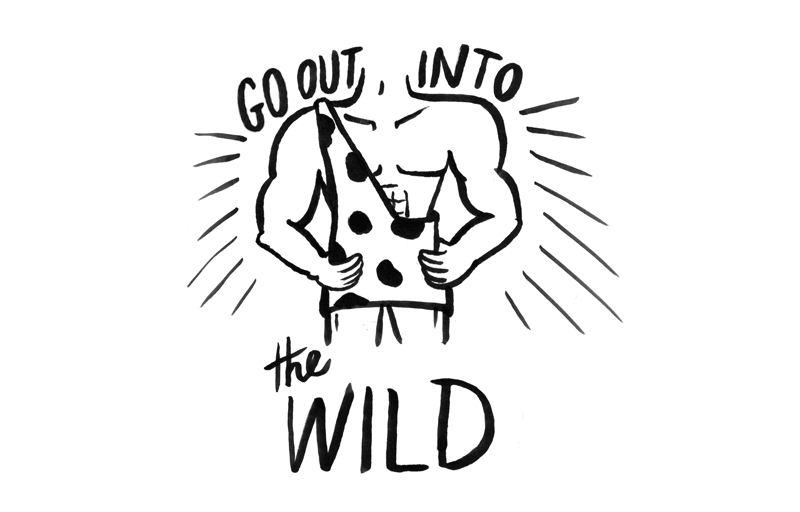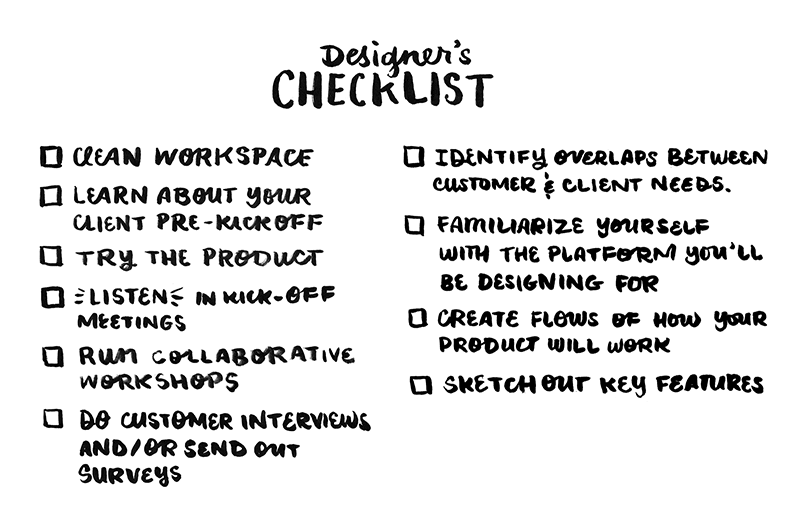The Power of Process
A couple of months ago I did a lightning talk at Kluge’s Evenings at the Loft sharing my ideal design process checklist. Here are my hand-drawn slides and notes:

In an ideal world all of these steps would happen on every project. Realistically, there is usually only time for some of them. The key is to be adaptable: realistic with the time given to you, and strategic about your choices.

This quote is self explanatory and my personal design mantra, stay away from the computer / visual design until you’re in a solid place with your ideas.

I like to start every project with a clean desk. I know it sounds a bit cliché but I find the state of my desk is a clear reflection of what’s going on in my head. A clean slate is the way I like to start each project. If you’re wondering what that mushroomy looking thing is in the middle of my drawing, it’s my handy desk vacuum.

It’s really worthwhile to learn as much as you can about your client before you get on-boarded to a project. That way you can have an informed outsiders view of the product before stepping into it from the brand’s perspective.

Use the product! Yes, that’s a bong and a dress. In my 10 year career I’ve worked in advertising with large fashion and beauty brands and now product side most recently with a medical marijuana company. While the products might vary quite a bit from project to project and most often you may not be in the target market, learn as much as you can about it and what role it plays in their customers’ lives. In this case, I think it helps to dabble in your own product.

Take the time to listen in meetings when you start a project. Yes, you were hired for your skills and expertise which you’ll have the opportunity to share soon enough. But, before you get to that part, make sure you let others in the room who’ve had a history with this product share with you what they’ve learned along the way.

Now that you’ve gathered preliminary information, run collaborative workshops with key stakeholders and see if everyone in the room is in agreement about what this product is doing, where it’s going and who is using it. And if they don’t, even better! You can start the dialogue in unifying people in the room to form a shared vision of what you’ll build together.

That’s right, put on your George of the Jungle skivvies and step outside. Do customer interviews, send out surveys and ask the people around you who fall in that customer base. Try and gather insights from the people who your product will matter to most, your customers.

This is a good time to see what the overlap is between what your customers want and what the stakeholders deem most important to the product. Chances are there is a good overlap of needs and some great insight on what’s unnecessary and best left in the icebox.

At this point you can start to dive in to preliminary prototyping. I like to start this by first refreshing my understanding and limitations of the platform I’m going to be designing for. Most recently I worked on an Android design project. Having little to no experience with Android I switched my phone and read up on design best practices.

Finally! The doodling can begin. Create flows of how your product will work. Start to sketch out key features and how they will integrate into your product. This is most effective when done with your whole team. Don’t isolate or hide your designs from stakeholders.

Maybe you’ll only get to do a couple of these activities or maybe if you’re lucky you’ll get to implement them all. Either way it’s good to be aware of the things you can and should do before you get to visual design. Even though clients sometimes might be tempted to complain that you’re lagging, help them realize this is all an important foundation to set before producing high fidelity designs.
Here is a checklist of all the steps I’ve talked about. If you’re a designer you might find it handy to refer to as you work through a project.
Yasmine Molavi
Designer and Illustrator based in Venice, California.